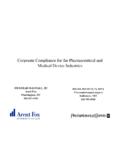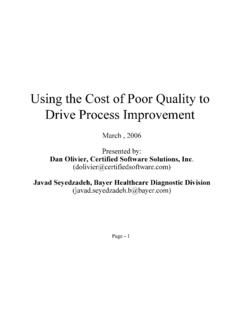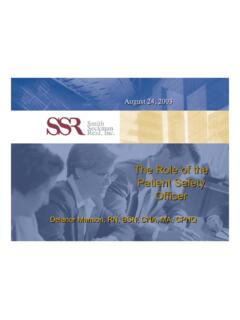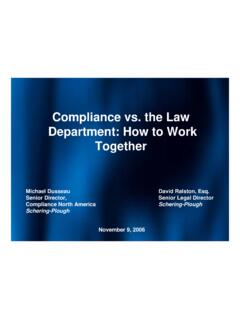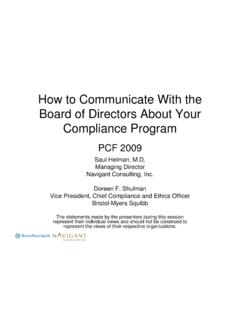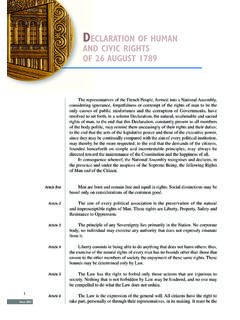Transcription of “Who Goes to Jail?” A Guide for HIPAA Privacy …
1 Who Goes to Jail? A Guide for HIPAA Privacy OfficersBy: Edward F. Malone, Esq. Jenner & Block, LLCC hicago, IllinoisHIPAA Protects Individually Identifiable Health Information (45 , , ) Protected Health Information (PHI) Individually Identifiable Information HIPAA Prohibits Disclosureof PHI Basic standard covered entities may not use or disclose PHI, except as specifically permitted or required by the regulations Minimum necessary requirementWho Is Subject To HIPAA S Privacy Regulations?( , ) Covered entities Business associatesThe Enforcement Provisions:42 1320d-5 & 1320d-6 42 1320d-5 covers civil violations 42 1320d-6 covers criminal violations These sections are not found in theHHSR egulations, rather they are Congressionally promulgated statutes found in the Penalty for Failure To Comply With Requirements And 1320d-5(Civil Violations) Punishes any violation of regulations Maximum penalty of $100 per violation Cap of $25,000 per calendar year for each provision of the regulations that are violatedWrongful Disclosure of Individually Identifiable Health Information:42 1320D-6(a)(Criminal Violations) Violation of federal law Violations must be committed knowingly MENS REA And Use Of The Word Knowingly A person commits an act knowingly when it is done purposefully.
2 That is, the act is a product of a conscious design, intent or plan that it be done. Horne v. State of Indiana, 445 976 (1983).Three Ways To Violate 42 1320d-6 Knowingly and in violation of the regulations using or causing to be used a unique health identifier; Knowingly and in violation of the regulations obtaining individually identifiable health information relating to an individual; and Knowingly and in violation of the regulations disclosing individually identifiable health information to another Penalties For Violating 1320d-6 Maximum penalties are set forth in 1320d-6(b) Actual sentencing is determined according to the Federal Sentencing Penalties(42 1320d-6(b)(1)) Any violation: $50,000 fine, one year imprisonment, or Penalties(42 1320d-6(b)(2)) If offense is committed under under false pretenses: $100,000 fine, 5 years imprisonment, or Penalties(42 1320d-6(b)(3)) If the offense is committed with the intent to sell, transfer, or use individually identifiable health information for commercial advantage, personal gain, or malicious harm.
3 $500,000 fine, 10 years imprisonment, or Statutes That Could Lead To Further Criminal Or Civil Liability For Violating HIPAA Wire and Mail Fraud Statues, 18 1341 & 1343 False Claims Act, 31 3729 Potential Bases For Criminal Liability Employee liability for employee s own conduct Liability of Privacy officers Corporate liability for acts of employees Concurrent liability of employees and corporationThe Federal Sentencing Guidelines Determining the offense level Determining criminal history category Determining the sentence Probable sentencing for violations of 42 1320d-6 Criminal History Category (Criminal History Points)OffenseLevelI(0 or 1)II(2 or 3)III(4,5,6)IV(7,8,9)V(10,11,12)VI(13 or more)10-60-60-60-60-60-620-60-60-60-60-6 1-730-60-60-60-62-83-940-60-60-62-84-106 -1250-60-61-74-106-129-1560-61-72-86-129 -1512-1870-62-84-108-1412-1815-2180-64-1 06-1210-1615-2118-2494-106-128-1412-1818 -2421-27106-128-1410-1615-21 21-2724-30118-1410 1612-1818-2424-3027-331210-1612-1815-212 1-2727-3330-37 Sentencing TableMinimizing Corporate Exposure To Civil And Criminal Liability By Conducting Internal Investigations Reasons for conducting an internal investigation Costs and risks associated with conducting an internal investigation Conducting the internal investigation so as to maximize benefits and minimize risksReasons For Conducting An Internal Investigation Ensuring compliance with the regulations Information gathering -determining the facts and available defenses Use in negotiation with the government Use at sentencing Public relationsCosts And Risks Associated With
4 Conducting An Internal Investigation Expense Disclosure of information Triggering enforcement actions Triggering collateral litigationBest Practices Conducting Internal Investigations So As To Maximize Benefits And Minimize Risks Inside v. outside counsel Maintaining confidentiality -cloak investigation with privilege Document review Witness interviews Dealing with a simultaneous government investigation Using experts Representing employees -conflict concerns Preparing the investigative report Benefits of disclosure of the results of an investigation Risks of disclosure of the results of an investigationApplication To A Hypothetical Situatio

